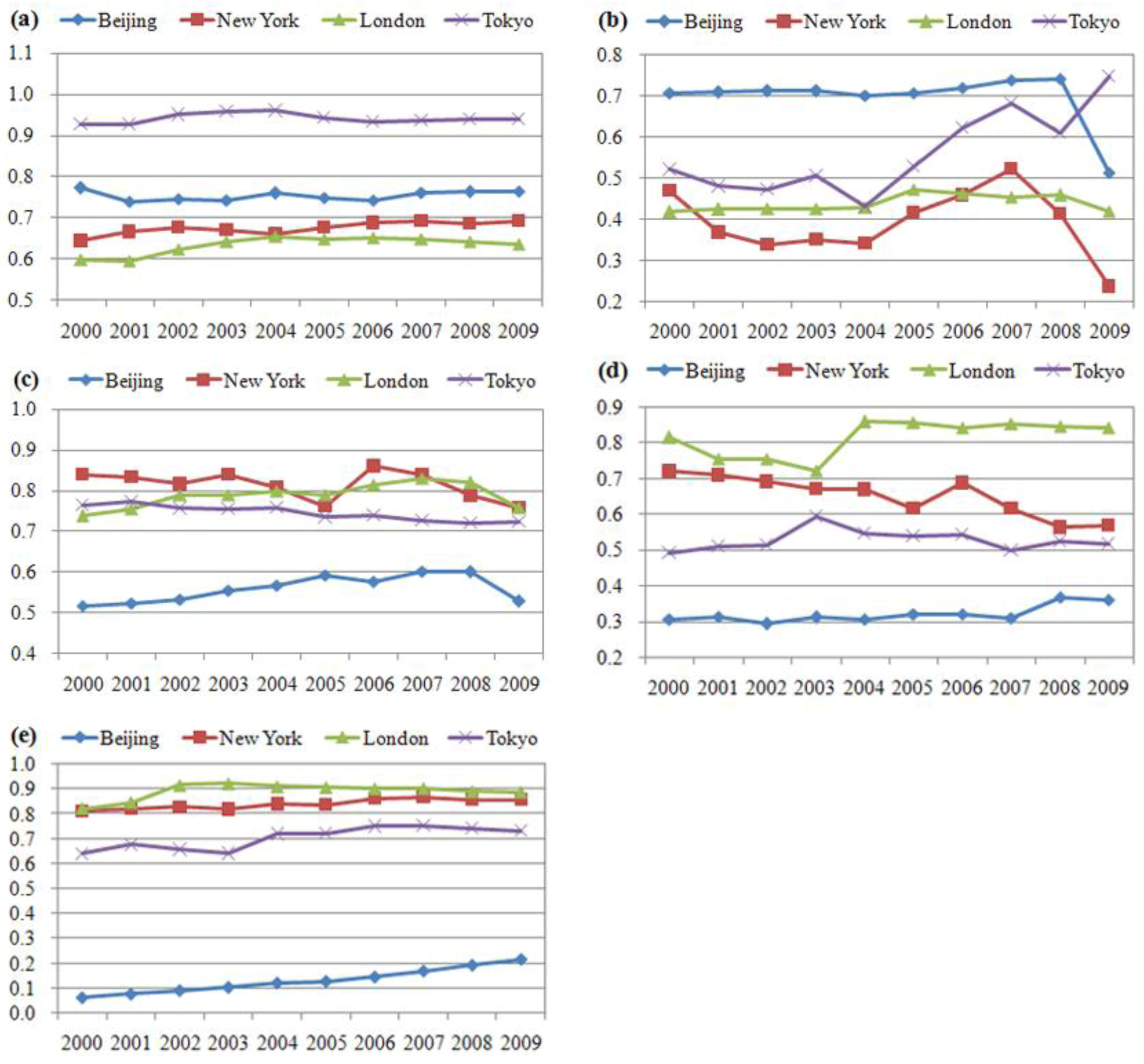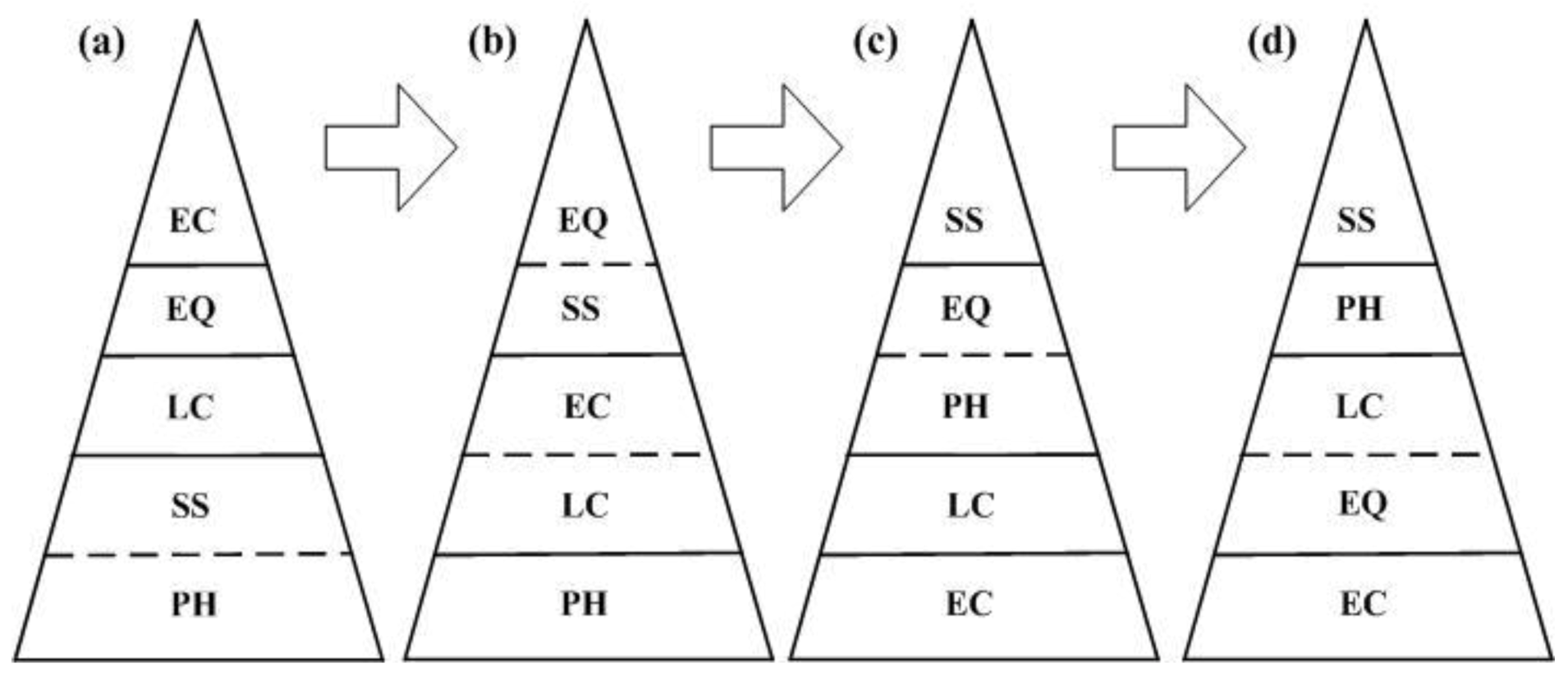Urban Public Health: Is There a Pyramid?
Abstract
:1. Introduction
2. Methods
2.1. Assessment Indicators of UPH
| Factors | Indicators | Unit |
|---|---|---|
| Physical health | Infant mortality rate | ‰ |
| Life expectancy | years old | |
| Number of doctors per 1,000 persons | - | |
| Number of hospital beds per 1,000 persons | - | |
| Living conditions | Per capita GDP | US $ |
| Angel’s coefficient | - | |
| Per capita living space | m2 | |
| Average commuting time | min | |
| Social security | Unemployment rate | % |
| Average daily crime incidents | - | |
| Traffic deaths per 10,000 vehicles | - | |
| Environmental quality | COD emission intensity per unit GDP | kg/104 US $ |
| Daily average SO2 concentration | mg/m3 | |
| Daily average NO2 concentration | mg/m3 | |
| Per capita public green areas | m2 | |
| Education and culture | Gross enrolment rate in tertiary education | % |
| Internet penetration rate | % | |
| Number of libraries per million persons | - |
2.2. Data Collection
2.3. Weighted Sum Model
2.4. Study Sites
3. Results
3.1. General UPH States of Four Cities

3.2. UPH Pyramid of Each City

3.3. UPH Pyramid Development Trend

4. Discussion
5. Conclusions
Acknowledgments
Conflict of Interest
References
- Huang, S.L. Urban ecosystems, energetic hierarchies, and ecological economics of Taipei metropolis. J. Environ. Manag. 1998, 52, 39–51. [Google Scholar] [CrossRef]
- Su, M.R.; Yang, Z.F.; Chen, B. Relative urban ecosystem health assessment: A method integrating comprehensive evaluation and detailed analysis. Ecohealth 2010, 7, 459–472. [Google Scholar] [CrossRef]
- Costanza, R. Toward an operational definition of ecosystem health. In Ecosystem Health: New Goals for Environmental Management, 1st; Costanza, R., Norton, B.G., Haskell, B.D., Eds.; Island Press: Washington, DC, USA, 1992; pp. 239–256. [Google Scholar]
- Rapport, D.J.; Gaudet, C.; Karr, J.R.; Baron, J.S.; Bohlen, C.; Jackson, W.; Jones, B.; Naiman, R.J.; Norton, B.; Pollock, M.M. Evaluating landscape health: Integrating societal goals and biophysical process. J. Environ. Manag. 1998, 53, 1–15. [Google Scholar] [CrossRef]
- Su, M.R.; Fath, B.D.; Yang, Z.F. Urban ecosystem health assessment: A review. Sci. Total Environ. 2010, 408, 2425–2434. [Google Scholar] [CrossRef]
- Khan, M.H. Urban health in megacities of developing countries. Publ. Health Forum 2012, 20. [Google Scholar] [CrossRef]
- Winslow, C.E.A. The untilled fields of public health. Science 1920, 51, 23–33. [Google Scholar]
- Garcia-Lacalle, J.; Martin, E. Rural vs. urban hospital performance in a ‘competitive’ public health service. Soc. Sci. Med. 2010, 71, 1131–1140. [Google Scholar] [CrossRef]
- Zhao, Y.; Cui, S.; Yang, J.; Wang, W.; Guo, A.; Liu, Y.; Liang, W. Basic public health services delivered in an urban community: A qualitative study. Publ. Health 2011, 125, 37–45. [Google Scholar] [CrossRef]
- Dahlgren, G.; Whitehead, M. Policies and Strategies to Promote Social Equity in Health. 1991. Available online: http://www.framtidsstudier.se/wp-content/uploads/2011/01/20080109110739filmZ8UVQv2wQFShMRF6cuT.pdf (accessed on 13 December 2012).
- Liu, S.; Griffiths, S.M. From economic development to public health improvement: China faces equity challenges. Publ. Health 2011, 125, 669–674. [Google Scholar] [CrossRef]
- World Health Organization. The Ottawa Charter for Health Promotion. 1986. Available online: http://www.who.int/healthpromotion/conferences/previous/ottawa/en/ (accessed on 13 December 2012).
- Whiteis, D.G. Third world medicine in first world cities: Capital accumulation, uneven development and public health. Soc. Sci. Med. 1998, 47, 795–808. [Google Scholar] [CrossRef]
- St Leger, L. Health and nature—New challenges for health promotion. Health Promot. Int. 2003, 18, 173–175. [Google Scholar] [CrossRef]
- Brown, T.; Bell, M. Off the couch and on the move: Global public health and the medicalisation of nature. Soc. Sci. Med. 2007, 64, 1343–1354. [Google Scholar] [CrossRef]
- Su, M.R.; Yang, Z.F.; Chen, B.; Ulgiati, S. Urban ecosystem health assessment based on emergy and set pair analysis—A comparative study of typical Chinese cities. Ecol. Model. 2009, 220, 2341–2348. [Google Scholar] [CrossRef]
- Wu, Z.; Li, Z.; Chen, G.Q. Multi-scale analysis for environmental dispersion in wetland flow. Commun. Nonlinear Sci. Numer. Simul. 2011, 16, 3168–3178. [Google Scholar] [CrossRef]
- Harpham, T. Urban health in developing countries: What do we know and where do we go? Health Place 2009, 15, 107–116. [Google Scholar] [CrossRef]
- Wang, J.; Su, M.R.; Chen, B.; Chen, S.Q.; Liang, C. A comparative study of Beijing and three global cities: A perspective on urban livability. Front. Earth Sci. 2011, 5, 323–329. [Google Scholar]
- Elton, C.S. The animal community. In Animal Ecology, 1st; Elton, C.S., Ed.; Macmillan Co.: New York, NY, USA, 1927; pp. 239–256. [Google Scholar]
- Davis, M.A.; Thompson, K.; Grime, J.P.; Charles, S. Elton and the dissociation of invasion ecology from the rest of ecology. Divers. Distrib. 2001, 7, 97–102. [Google Scholar]
- Odum, E.P.; Barrett, G.W. Fundamentals of Ecology, 5th ed; Brooks Cole: Florence, Italy, 2004. [Google Scholar]
- Maslow, A.H. A theory of human motivation. Psychol. Rev. 1943, 50, 370–396. [Google Scholar] [CrossRef]
- Shafik, N. Economic development and environmental quality: An econometric analysis. Oxf. Econ. Paper. 1994, 46, 757–773. [Google Scholar]
- Diener, E.; Ng, W.; Harter, J.; Arora, R. Wealth and happiness across the world: Material prosperity predicts life evaluation, whereas psychosocial prosperity predicts positive feeling. J. Pers. Soc. Psychol. 2010, 99, 52–61. [Google Scholar] [CrossRef]
- Su, M.R.; Fath, B.D. Spatial distribution of urban ecosystem health in Guangzhou, China. Ecol. Indicat. 2012, 15, 122–130. [Google Scholar] [CrossRef]
© 2013 by the authors; licensee MDPI, Basel, Switzerland. This article is an open access article distributed under the terms and conditions of the Creative Commons Attribution license (http://creativecommons.org/licenses/by/3.0/).
Share and Cite
Su, M.; Chen, B.; Yang, Z.; Cai, Y.; Wang, J. Urban Public Health: Is There a Pyramid? Int. J. Environ. Res. Public Health 2013, 10, 490-498. https://doi.org/10.3390/ijerph10020490
Su M, Chen B, Yang Z, Cai Y, Wang J. Urban Public Health: Is There a Pyramid? International Journal of Environmental Research and Public Health. 2013; 10(2):490-498. https://doi.org/10.3390/ijerph10020490
Chicago/Turabian StyleSu, Meirong, Bin Chen, Zhifeng Yang, Yanpeng Cai, and Jiao Wang. 2013. "Urban Public Health: Is There a Pyramid?" International Journal of Environmental Research and Public Health 10, no. 2: 490-498. https://doi.org/10.3390/ijerph10020490
APA StyleSu, M., Chen, B., Yang, Z., Cai, Y., & Wang, J. (2013). Urban Public Health: Is There a Pyramid? International Journal of Environmental Research and Public Health, 10(2), 490-498. https://doi.org/10.3390/ijerph10020490





